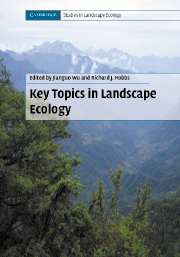Book contents
- Frontmatter
- Contents
- List of contributors
- Preface
- PART I Introduction
- PART II Key topics and perspectives
- 2 Adequate data of known accuracy are critical to advancing the field of landscape ecology
- 3 Landscape pattern analysis: key issues and challenges
- 4 Spatial heterogeneity and ecosystem processes
- 5 Landscape heterogeneity and metapopulation dynamics
- 6 Determining pattern–process relationships in heterogeneous landscapes
- 7 Scale and scaling: a cross-disciplinary perspective
- 8 Optimization of landscape pattern
- 9 Advances in detecting landscape changes at multiple scales: examples from northern Australia
- 10 The preoccupation of landscape research with land use and land cover
- 11 Applying landscape-ecological principles to regional conservation: the WildCountry Project in Australia
- 12 Using landscape ecology to make sense of Australia's last frontier
- 13 Transferring ecological knowledge to landscape planning: a design method for robust corridors
- 14 Integrative landscape research: facts and challenges
- PART III Synthesis
- Index
- References
9 - Advances in detecting landscape changes at multiple scales: examples from northern Australia
Published online by Cambridge University Press: 12 January 2010
- Frontmatter
- Contents
- List of contributors
- Preface
- PART I Introduction
- PART II Key topics and perspectives
- 2 Adequate data of known accuracy are critical to advancing the field of landscape ecology
- 3 Landscape pattern analysis: key issues and challenges
- 4 Spatial heterogeneity and ecosystem processes
- 5 Landscape heterogeneity and metapopulation dynamics
- 6 Determining pattern–process relationships in heterogeneous landscapes
- 7 Scale and scaling: a cross-disciplinary perspective
- 8 Optimization of landscape pattern
- 9 Advances in detecting landscape changes at multiple scales: examples from northern Australia
- 10 The preoccupation of landscape research with land use and land cover
- 11 Applying landscape-ecological principles to regional conservation: the WildCountry Project in Australia
- 12 Using landscape ecology to make sense of Australia's last frontier
- 13 Transferring ecological knowledge to landscape planning: a design method for robust corridors
- 14 Integrative landscape research: facts and challenges
- PART III Synthesis
- Index
- References
Summary
Introduction
As we move into a new century, changes in the cover and condition (or “state of health”; see Section 9.3) of different landscapes continue under human influences. Our responses to landscape changes are often slow because subtle problems often go undetected, resulting in costly long-term environmental and socio economic problems (Scheffer et al. 2003). Landscape changes are also spatially heterogeneous and occur at different scales, and it is difficult to select the appropriate scale for analysis (Gustafson 1998). As landscape ecologists, we are perhaps best at quantifying biophysical changes at fine scales (e.g., plots of 1–100m2) using ground-based data and at coarse scales (e.g., regions and catchments of >100km2) using satellite imagery (Ludwig et al. 2000). However, between fine plots and coarse regions, that is, at local watershed and pasture scales (e.g., 1–100km2), where management actions are often most urgently needed, changes in land condition often go undetected. A key challenge for us is to develop methods and indicators that will readily detect changes in land cover and condition at these watershed and pasture scales, as well as at fine plot and coarse regional scales.
Thus, landscape change information is needed at multiple scales, from fine to coarse. In Australia, land cover and condition changes are used at the very coarse national scale (i.e., 7.7 millionkm2) for periodic reporting on the “State of the Environment” (Hamblin 2001), which is used to guide national environmental policies.
- Type
- Chapter
- Information
- Key Topics in Landscape Ecology , pp. 161 - 172Publisher: Cambridge University PressPrint publication year: 2007
References
- 1
- Cited by

